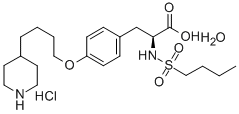Tirofiban was launched as Aggrastat in Switzerland and the US for
patients with unstable angina or non-Q-wave myocardial infarction to prevent
cardiac ischemic events. Tirofiban is synthesized from (S)-tyrosine by a fourstep
process. Tirofiban is a novel highly potent antiplatelet agent that inhibits the
interaction of fibrinogen with GPⅡb/Ⅲa, an activated platelet membrane-bound
glycoprotein complex. It prevents arterial thrombus formation in a dosedependent
manner. Clinical efficacy was highly significant with an absolute and
relative risk reduction. In these studies, treatment with tirofiban was well
tolerated, without significant adverse effects.
Sibutramine (Sibutramine)
Tirofiban Hydrochloride is a selective nonpeptide platelet glycoprotein IIb/IIIa antagonist.
Aggrastat (Millot
Laboratories, France).
The synthesis of tirofiban starts by reaction of tyrosine with bis-trimethylsilyl
trifluoraceramide to give a derivative in which both functions -OH and COOH_x0002_are protected. Treatment of this intermediate with butylsulfonyl chloride gives
the corresponding sulfonamide derivative; the quite labile silyl groups are then
removed under mildly acidic conditions to give N-butylsulfonyl-tyrosine. In a
parallel scheme, 4-picoline is converted to its anion by means of butyl lithium;
this gives 4-(4-chlorobutyl)-pyridine on alkylation with 1-bromo-3-
chloropropane. The reaction of this compound with N-butylsulfonyl-tyrosine in
presence of NaOH gives the ether 2-butylsulfonyaminol-3-[4-pyridin-4-yl�butoxy-phenyl]propionic acid. Hydrogenation over palladium on charcoal then
reduce the pyridine ring to a piperidine to afford the fibrinogen receptor
antagonist tirofiban.
Tirofiban is INN and BAN.
Fibrinogen receptor antagonist



